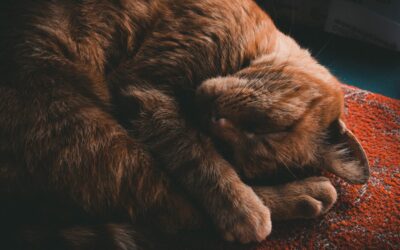For cat owners, pet lovers, and animal enthusiasts, the question remains—why do cats purr? Cats are mysterious creatures, captivating us with their enigmatic behaviors and unique vocalizations. Among these, cat purring stands out as both a soothing lullaby and an intriguing mystery. This blog post unravels this feline phenomenon, exploring its origins, significance, and the deeper connections it creates between cats and humans.
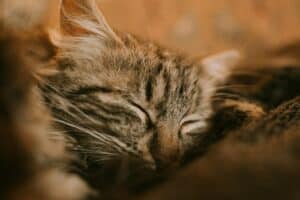
The Science Behind Cat Purring
When a cat purrs, it often signifies contentment and relaxation. But there’s more to this rhythmic sound than meets the eye—or rather, the ear. The purring sound originates from a cat’s voice box where the vocal cords are located. When a cat breathes in and out, air vibrates the muscles within the larynx, creating that familiar purring sound that resonates at a low frequency.
Interestingly, while most domestic cats can purr, not all felines share this ability. The capability to produce a purring sound distinguishes domestic cats from their larger wild cousins, such as lions and tigers, who roar instead. This purring ability is thought to have evolved as a means for mother cats to communicate with their kittens, who are born blind and rely on their mother’s purring to locate her for food and warmth.

Why Do Cats Purr? The Many Meanings Behind the Purr
A cat’s purr has been a vital tool for communication from their earliest days. Mother cats use purring to signal safety and reassurance to their kittens. This soothing sound helps newborns find their way to their mother’s milk, guiding them with a vibration they can feel and hear. Kittens purr back to their mothers, indicating well-being and comfort, creating a bonding experience rooted in mutual trust and care.
Healing Powers and Self-Soothing
Beyond communication, cat purring has fascinating physiological benefits. Studies suggest that a purring cat may tap into its biological healing powers. The low-frequency vibrations of a cat’s purr have been linked to increased bone density and the healing of broken bones. These vibrations may also help decrease pain and promote wound healing, acting as a natural self-soothing mechanism for cats in distress.
Emotional Response and Social Interaction
Cat purring isn’t limited to kittens and their mothers. For adult cats, purring can serve as an emotional response to their environment. When a purring cat sits close, eyes half-closed, it’s often expressing a happy mood and a sense of contentment. It’s a form of body language, an indicator of a relaxed environment where the cat feels safe. However, it’s important to recognize that purring can also occur when a cat is anxious or unwell, as it attempts to self-soothe.
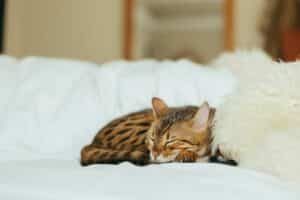
Distinguishing Between Pain and Joy in Purring
Understanding whether a cat is purring from pain or joy can be challenging, as the sound itself may appear similar in both scenarios. However, keen observation of a cat’s behavior and body language can provide essential cues. When a cat is doing a normal purr in a state of contentment, it often exhibits relaxed body postures, such as lying comfortably, kneading with its paws, or seeking proximity to its owner. In these moments, purring is typically accompanied by soft, slow movements, indicating a peaceful state.
Conversely, if a cat is purring due to discomfort or pain, the behavior may differ significantly. Signs of distress can include a tense body, a tucked tail, or attempts to hide. Additionally, the purring may come in shorter bursts or be interspersed with other vocalizations like whines or growls.
It’s important for cat owners to monitor any changes in their pet’s usual behavior, such as reduced appetite or avoidance of interaction, which may signify that the purring is a response to pain rather than pleasure. If there’s any uncertainty, consulting a veterinarian is advisable to ensure the well-being of the feline companion.
Resources for Understanding Purring and Feline Well-being
To further explore the intriguing world of cat purring and animal behavior, consider utilizing the following resources:
- American Association of Feline Practitioners – A valuable resource for feline health and behavior, including insights on cat communication.
- Catster – An online community that offers articles and tips on cat care, behavior, and understanding the nuances of feline sounds.
- The Spruce Pets – This site features various guides on feline behavior, including detailed discussions about purring and stress relief techniques for cats.
Products to Soothe Cats While Purring
To enhance the soothing experience associated with cat purring, consider the following products designed to cater to your feline friend’s comfort:
- PetFusion Ultimate Cat Scratcher Lounge – A multi-functional scratcher that provides a cozy space for cats to relax and enjoy soothing vibrations while purring.
- Thundershirt Classic Dog Anxiety Jacket– Though designed for dogs, many cat owners report success in using this snug-fitting garment to help soothe anxious cats, making them feel secure while they purr.
- PetSafe ScoopFree Ultra Self-Cleaning Litter Box – A hassle-free litter box option that keeps your space clean, allowing your cat to feel comfortable and stress-free, encouraging a soothing environment for purring.
- PawHut Cat Tree with Perch and Scratching Posts – This cat tree provides various levels for climbing, lounging, and scratching, helping your cat feel safe and secure, thereby promoting relaxation and purring.
These resources and products can help enrich your understanding of the cat purr while supporting a serene environment for your furry companion.

Decoding the Language of Cat Purrs
For cat owners, interpreting a cat’s purring can deepen the bond between human and your furry friend. Observing a cat’s body language alongside its purr provides valuable insights. A cat curled up, relaxed, and softly purring likely indicates a pleasant mood. Conversely, a purring cat with tense muscles, flattened ears, or hiding behavior might be experiencing stress or discomfort and could benefit from attention or a visit to the veterinarian.
The Role of Humans in a Cat’s Life
Cats aren’t just solitary creatures; they cherish social interactions with their human companions. Petting a cat often triggers purring, indicating a symbiotic relationship where both parties find joy and comfort. Some studies even suggest that the frequency of a cat’s purr can ease breathing in humans, promoting relaxation and reducing anxiety, showcasing the reciprocal benefits of this unique bond.
Purring Cats in a Multi-Animal Household
In homes with multiple animals, understanding the dynamics of cat purring becomes essential. Cats may purr to communicate with other pets, including dogs, signaling non-aggression and fostering a peaceful coexistence. Observing these interactions can offer valuable insights into the social hierarchy and emotional state of the animals involved.
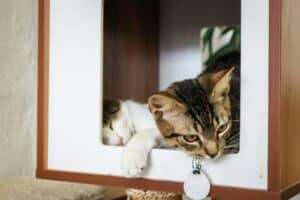
A Cat’s Purr And The Impact on Cat Owners
A cat purr doesn’t just impact the cat, but it also impacts the owners in the best ways possible.
Emotional and Physical Benefits
For cat owners, the gentle sound of your feline friend is more than a pleasant background noise. It has been shown to have calming effects, reducing stress and anxiety levels in humans. The rhythmic vibrations can lower blood pressure, creating a serene atmosphere that fosters overall well-being. Cat owners often find solace in the presence of their purring pets, experiencing a sense of happiness and relaxation.
Building a Stronger Bond
Understanding why cats purr enhances the connection between humans and their furry friends. By recognizing the various meanings behind a cat’s purr, owners can tailor their interactions to meet their pet’s emotional needs. Whether it’s providing a comforting environment or engaging in play, responding to a cat’s cues strengthens the bond and promotes a harmonious relationship.
Creating a Relaxed Environment
To encourage purring and ensure a cat’s happiness, owners should strive to create a relaxed environment. Providing cozy spots for rest, engaging in interactive play, and offering a balanced diet contribute to a cat’s well-being. Regular veterinary check-ups and attention to any changes in behavior can help identify and address potential health concerns.
Unveiling the Mysteries of the Purr
The fascinating aspect of a cat’s purr lies in its potential healing powers. The low-frequency vibrations emitted during purring have been associated with various health benefits. Research suggests that these vibrations can promote bone healing, alleviate pain, and aid in the recovery of injured tissues. While further studies are needed to fully understand the extent of these effects, the evidence points to the remarkable capabilities of a purring cat.
Exploring Evolutionary Theories
The origins of purring trace back millions of years, with evolutionary theories shedding light on its significance. Some scientists propose that purring evolved as a survival mechanism, allowing cats to conserve energy while resting or hunting. Others suggest that it serves as a form of communication within feline communities, enabling cats to convey information without alerting prey or potential threats.
Beyond Cats Other Purring Animals
While cats are the most well-known purrers, they’re not the only animals capable of producing this soothing sound. Certain wild felines, such as cheetahs and bobcats, also exhibit purring behavior. Additionally, some domesticated animals, like rabbits and guinea pigs, can produce similar low-frequency vocalizations, highlighting the widespread nature of purring across the animal kingdom.
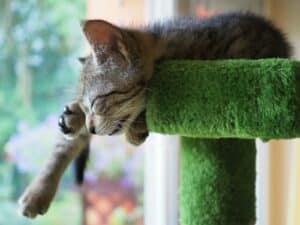
The Future of Purring Research
As our understanding of purring continues to evolve, ongoing research aims to uncover its complexities. Scientists are exploring the precise mechanisms behind purring and its potential applications in areas such as pain management and rehabilitation. By unraveling the mysteries of purring, researchers hope to unlock new insights into the broader field of animal communication and human-animal interactions.
Integrating Technology into Purring Research
With advancements in technology, researchers are utilizing innovative tools to study purring in more detail. High-resolution sound analysis, motion tracking, and biofeedback systems enable scientists to gather precise data on purring frequencies, patterns, and their effects on both cats and humans. These technological advancements hold the promise of deepening our understanding of the purring phenomenon.
Harnessing the Potential of Purring for Well-being
Beyond scientific exploration, the potential applications of purring extend to promoting human well-being. Therapists and healthcare professionals are investigating the use of purring as a complementary therapy for stress reduction, relaxation, and emotional support. By harnessing the calming vibrations of a cat’s purr, individuals may experience improved mental and physical health.

Kate’s K9 Pet Care offers the best services for your feline and canine friends! Contact us today!
Conclusion A Symphony of Purring
In the world of domestic cats, the purring sound is a symphony of mystery, communication, and healing. For cat owners, pet lovers, and animal enthusiasts, understanding why cats purr opens the door to a deeper connection with their feline companions.
From the soothing vibrations that promote relaxation to the evolutionary significance embedded in each purr, the act of purring is a testament to the complexity and beauty of the animal kingdom.
Incorporating this knowledge into daily interactions with cats can enhance the bond between humans and their furry friends, creating a harmonious environment filled with love and understanding.
Whether it’s deciphering the language of a cat’s body or exploring the potential healing powers of purring, the mysteries of purring invite us to continually learn, appreciate, and cherish the unique connection we share with our feline companions.
For those seeking further exploration, resources on feline behavior, purring studies, and practical tips can guide the way. May the gentle hum of a purring cat always bring joy, comfort, and a sense of wonder to your life.




